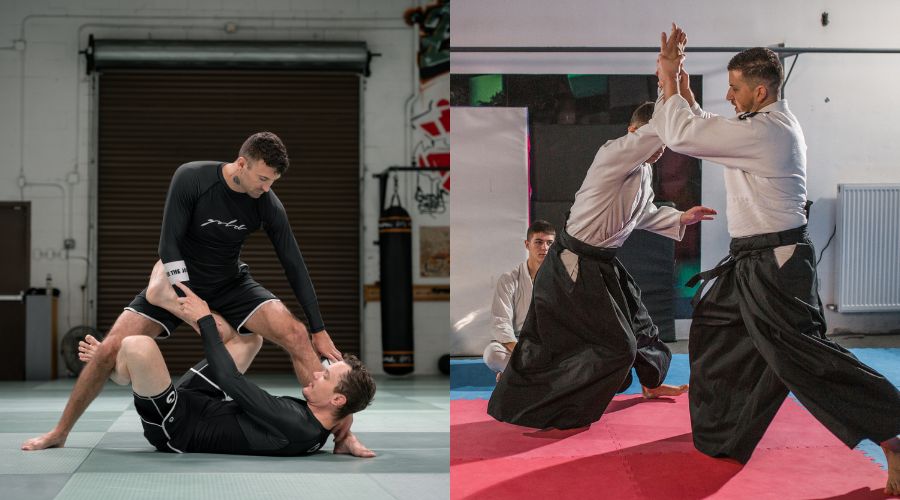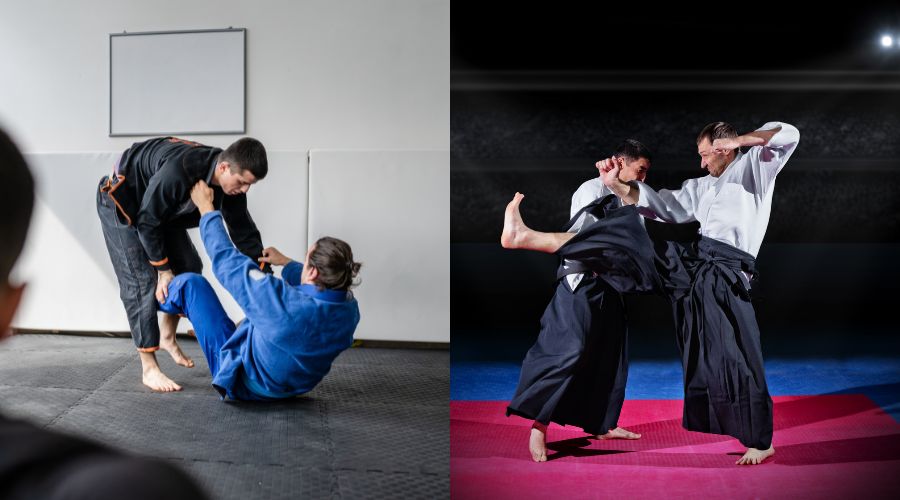Aikido has a worldwide following and is among the most popular martial arts. But while in the 20th-century style vs. style, battles were more theoretical, and Aikido was thought to be a legitimate style.
In today’s martial arts landscape, it has a notoriously bad reputation for being ineffective in real fight or combat sports.
On the opposite side, jiu-jitsu is often lauded as one of the most effective styles for self-defense and MMA.
BJJ is better than Aikido for learning to fight and self defense. It involves regular sparring with resisting opponents. Aikido focuses on training against unresisting opponents and involves little to no sparring or competition.
But there is more than simple effectiveness that goes into a martial art, and some people might wonder which of the two is the better choice for them, and this article will steer them in the right direction.
What Is BJJ?
Brazilian Jiu-Jitsu is a grappling martial art focused on dominating a fight on the ground through leverage, superior positioning, and submission holds.
First created as a self-defense system, BJJ today is more popular as a grappling-only combat sport with a very well-developed competition scene.
The roots of BJJ lie in Japanese jiu-jitsu, modified by the creator of Judo, Jigoro Kano. Then a student of Kano and master catch wrestler named Mitsuyo Maeda traveled to Brazil in the early 20th century, where he started teaching students, including brothers Carlos and Helio Gracie.
The Gracie family and other schools began developing their own version of the martial art, which gradually became a distinct style focused more on the ground fighting rather than the throws like Judo.
The Gracies traveled to the USA to popularize their style, and their immense success came with the first UFC events in the 1990s, won by Royce Gracie. Since then, jiu-jitsu has exploded as part of MMA and a separate sport.
The constant competition and ever-growing scene continuously evolve the style making it better and more complex as time goes by.
What Is Aikido?
Aikido is a Japanese martial art created in the 1920s and 1930s by Morihei Ueshiba, affectionately known as “Osensei” by Aikido practitioners.
Ueshiba studied various Japanese martial arts, including Daito-ryu Aiki-jujutsu, Judo, and Kenjutsu swordsmanship, which he implemented into his new style, which was formally recognized in 1942.
Morihei Ueshiba was heavily influenced by the neo-Shinto religion, which teaches non-violence, and the ideas laid the foundations of Aikido.
Ueshiba emphasized mastering the technique of receiving an attack and harmlessly redirecting it, with the ideal outcome being not only protection for the receiver but also leaving the attacker uninjured.
Aikido spread worldwide and is now taught in over 140 countries. Like many other Japanese martial arts, it has split into sub-styles, versions, and organizations, each altering some aspects based on their beliefs and understanding.
Key Differences Between BJJ And Aikido

Philosophy
The philosophy of Aikido is perhaps more important than anything else about it. Unlike all other martial arts, Aikido is a way of peace and harmony. It aims to prevent the practitioner from harm and neutralize the attacker inflicting minimal damage.
All Asian martial arts have a strong spiritual backbone and are physical and mental practices, but in Aikido, the mental part is equal to the physical one.
The whole idea of Aikido is to be a way of harmony and peace and defeating opponents without causing them harm while cultivating a strong and noble spirit.
BJJ may be translated as the gentle art, but it’s very far from it. While the submissions hold and positions can be used to subdue an opponent without causing him damage, each of the moves can lead to a serious injury, unconsciousness, or even death.
Jiu-jitsu was conceived as a self-defense system and a style to fight other styles and, as such, is drastically more violent than Aikido.
Techniques
Aikido techniques primarily use various throws to counter specific strike patterns. The majority of throws end in a joint lock or pin.
Wrist manipulation and redirecting the attacker’s energy are the main principles used in Aikido throws to cause the defender to throw the attacker into an impressive-looking flip and finish with some form of wrist or arm lock.
All of the techniques in Aikido aim to blend with the attacker’s energy and control him with minimal effort. The techniques aim to harmlessly deflect the attacks rather than to hurt the opponent.
BJJ focuses almost entirely on ground fighting, and most techniques reflect that. A key concept is positioning, meaning you must first assume a dominant position that allows you to control the opponent and then look for a submission.
The most distinct positions in jiu-jitsu are the guards, which allow you to fight effectively from your back, something not found in any other grappling martial art.
BJJ also employs the most extensive repertoire of submissions, including numerous joint locks like the armbar, heel hook, and Kimura lock and strangulations like the guillotine, rear naked choke, and triangle choke.
Competition
Competition is a core element of Brazilian jiu-jitsu and helped the martial grow so quickly worldwide.
The vast competition scene constantly pushes the sport forward both in popularity and technically. In recent years the no-gi competition scene is becoming more and more professional similar to other combat sports like boxing and MMA.
On the other hand, traditional Aikido is non-competitive because competition is against the philosophical principles of the martial art.
However, some Aikido styles, namely Tomiki and Shodokan, employ competitions, often using weapons like sticks imitating knives. This is in no way the norm, though, and very few styles and schools of Aikido participate in any form of competition.
Training
Aikido training is based on assigning a specific role for the training partners and having them drill pre-determined forms.
One is a receiver of the technique, or the one defending person called a tori, while the attacker is called a uke. Both parts play their role as the uke attacks with a strike or a hold which is then neutralized by an aikido technique by the tori.
At the higher level of Aikido, there are also multiple attacker sequences. Another key feature of the style is weapons training, which is absent from most other martial arts, including BJJ. This includes training with and disarming wooden staffs, knives, and swords.
The vast majority of aikido styles do not include any sparring and free training and only stick to the pre-determined forms style of training.
Contrary to these principles, BJJ is all about free practice and sparring. In fact, this has been the biggest reason jiu-jitsu has become so effective for MMA and self-defense.
Typical BJJ practitioners do a free sparring called rolling every class after drilling specific techniques in a more controlled manner with less resistance.
BJJ vs. Aikido For Self-Defense

So much has been said about the practicality of Aikido on both sides of the spectrum. The reality of fighting in the age of MMA and countless hours of footage of real street fights with trained and untrained people has shown us that Aikido does not work in any real scenario.
At the same time, BJJ is effective and proven to be an excellent self-defense martial art.
Mechanically the techniques in Aikido are good and look like they can work. But the problem is that in Aikido, the opponents start with a super unrealistic attack from the uke and then turn into a dummy offering no resistance to the defender Tori.
Then the uke does a spectacular flip and ends up on the ground, where he is put into an arm lock.
The arm lock may break the arm, but only if the person lays flat and waits for it, while the one applying it has no control over his body. In any even remotely real situation, the person on the bottom will turn towards his arm or at least spazz around because he is not controlled, and the submission will be gone.
In every Aikido sequence I have watched, aside from the few styles that have a form of sparring and competition, one person goes limp and does not offer any resistance after the initial attack.
Anyone with experience, even in play wrestling as a kid, knows this is not how a fight goes or even a friendly sparring. This makes Aikido completely unrealistic and unusable against a resisting and aggressive opponent.
BJJ vs Aikido For MMA
The same thing from the last paragraph applies to the practicality of Aikido for MMA. Without training against a resisting opponent, no techniques will work in MMA or a real fight.
Not only does Aikido lack any realistic training, but the whole idea is to not harm the opponent, whereas the sport of MMA is aimed at exactly that, hurting the opponent. So naturally, Aikido has no use in MMA.
Brazilian jiu-jitsu has been a foundational style of mixed martial art since day one and still is a part of the core skills any fighter must have, at least to a decent degree.
In defense of Aikido, many of the principles are solid; it’s mainly the type of training that makes them useless in a real scenario. Here is a good video of how Aikido principles may be transferred into a cage match.
BJJ vs. Aikido Who Would Win?
Again, the answer is straightforward- BJJ wins every time simply because it’s created and practiced with fighting in mind, while Aikido is not.
There are many videos showcasing the ease with which even mediocre MMA or kickboxing practitioners deal with Aikido, like this one:
Perhaps no other Aikidoka has gone to such lengths to realize how bad Aikido is for fighting and then try to make it work than Rokas from the Martial Arts Journey YouTube channel.
His whole channel is a fascinating journey in martial arts and is one of the few that has made Aikido work in a more realistic situation.
Which Is Better, BJJ or Aikido?
Most of the article may seem like a dig at Aikido, but it’s just a realistic assessment of both styles. Brazilian jiu-jitsu is immeasurably better at any practical aspect, but this does not mean Aikido is bad.
Aikido is a beautiful and peaceful practice that includes a strong spiritual element. It is holistic and great for the mind and the body with its graceful movements and strict traditions.
It’s truly an art, though the martial elements of it are almost completely missing. If this is your thing, then Aikido will be an excellent fit.
But if you want livelier practice, competition spirit, and effective self-defense skills, jiu-jitsu is far superior.
